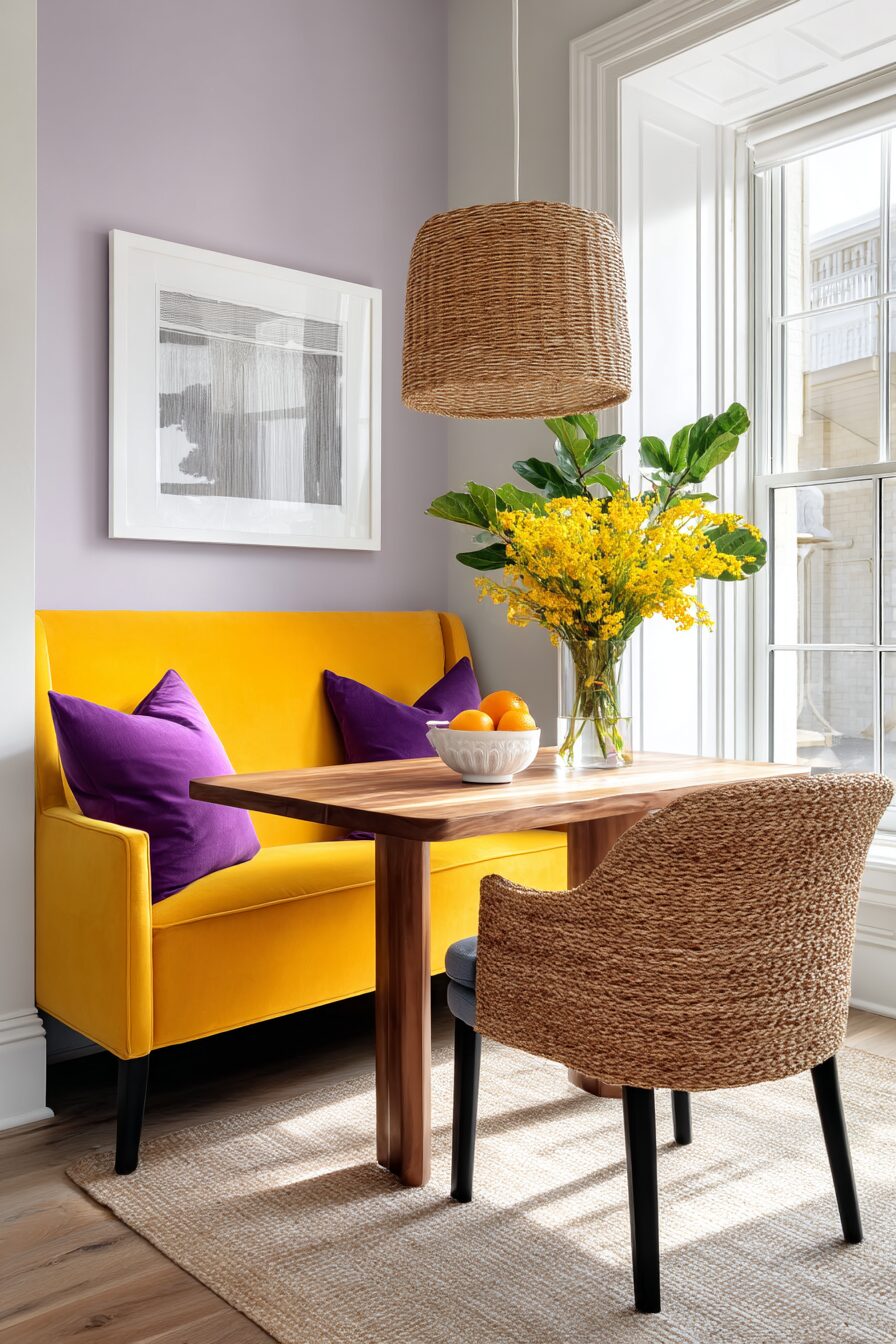Dining nooks are those special little corners in your home where magic happens over breakfast, lunch, and dinner conversations.
These cozy spaces combine comfort and style while maximizing even the smallest areas in your home.
Window-Side Breakfast Nook with Built-In Storage
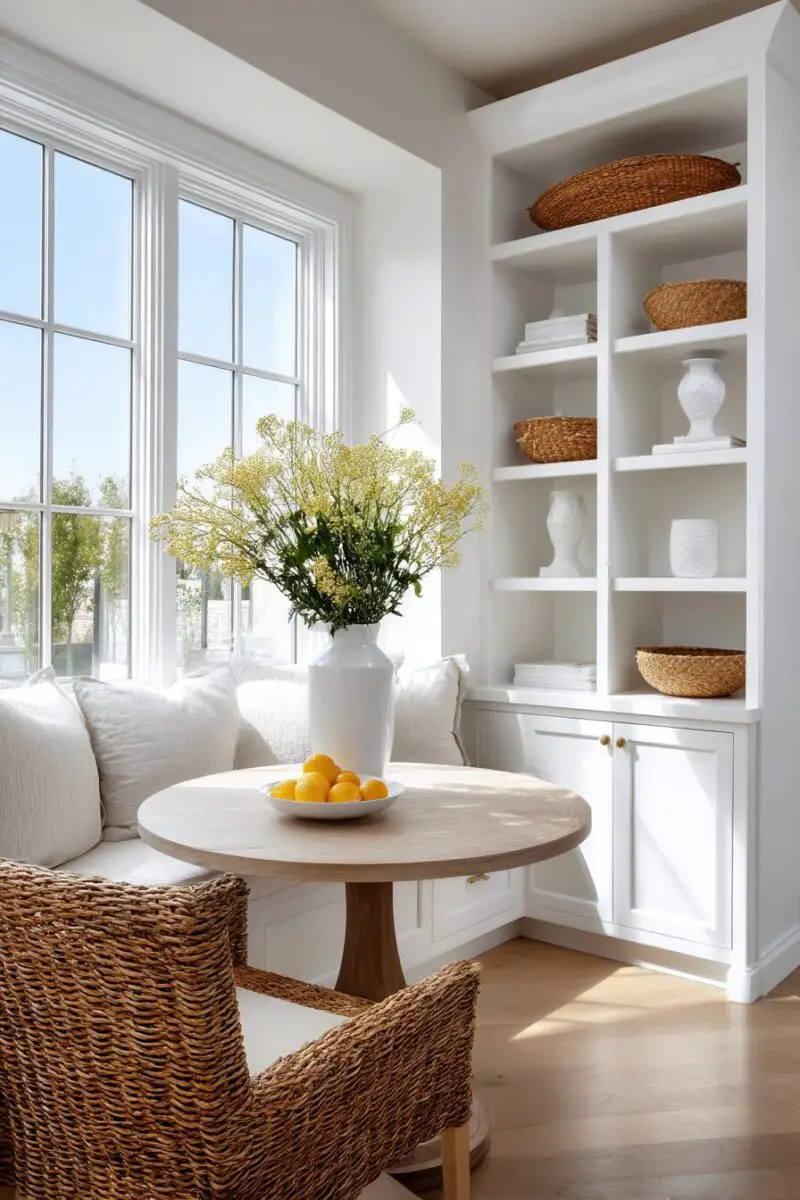

Imagine waking up to sunshine streaming across your breakfast table while you sip your morning coffee.
Window-side dining nooks capitalize on natural light, creating an energizing space that feels both intimate and expansive.
These light-filled corners become instant focal points in your home, drawing family members together for meals and moments that matter.
The key to a perfect window nook is positioning your seating to maximize the view while maintaining comfort and functionality.
L-shaped or U-shaped bench seating tucked directly under windows creates an inviting spot that feels custom-designed for your space.
Adding built-in storage underneath the benches doubles the functionality, giving you hidden space for table linens, seasonal decor, or even kids’ art supplies.
Choose weather-resistant, fade-resistant fabrics for cushions if your windows receive direct sunlight to ensure longevity.
Lightweight, sheer curtains can filter harsh light while maintaining the bright, airy feel that makes these nooks so appealing.
Round or oval tables work particularly well in these spaces, softening the corners and allowing for better traffic flow.
Adding a pendant light or small chandelier that hangs approximately 30 inches above your table creates ambiance while providing task lighting for meals and activities.
Window nooks work in virtually any design style, from farmhouse charm with beadboard detailing to sleek contemporary spaces with clean lines and minimal ornamentation.
For extra coziness, add a collection of throw pillows in various sizes that complement your overall color scheme but introduce interesting patterns and textures.
Installing a shelf above the window creates display space for plants, family photos, or seasonal decorations that personalize your nook.
The beauty of window-side dining nooks is their ability to connect your indoor dining experience with outdoor views, making even quick weekday breakfasts feel special and intentional.
TRENDING NOW
13 SMALL Living Room/Dining Room Combo IdeasCozy Corner Banquette with Bold Statement Colors

Corner banquettes transform those awkward, unused corners into the most sought-after seats in your home.
These L-shaped or corner-hugging configurations maximize seating while minimizing the footprint of your dining area.
The magic of a corner banquette lies in its bold use of color, which can transform a forgotten corner into a design statement that anchors your entire space.
Think jewel-toned velvets in emerald green or sapphire blue that invite lingering conversations over dessert and coffee.
The high backs of banquette seating create a sense of enclosure and intimacy that makes diners feel protected and comfortable.
This psychological effect explains why restaurant booths are always in higher demand than center tables – we’re naturally drawn to spaces that feel like protective cocoons.
When designing your bold banquette, consider contrasting piping or welting in a complementary color to add definition and designer detail.
Tufted backs add texture and interest while providing comfortable support for longer seating sessions.
The beauty of built-in banquettes is their ability to conform perfectly to your available space, making use of every inch in ways that free-standing furniture simply cannot.
For smaller spaces, consider extending the banquette slightly beyond the corner to create more seating without encroaching on walkways.
Rounded ends rather than sharp corners improve flow and prevent painful hip bumps when navigating around the dining area.
Pair your bold banquette with more subdued chairs on the opposite side of the table to balance the visual weight and avoid overwhelming the space.
Lighting plays a crucial role in banquette design – a statement pendant or small chandelier centered over the table defines the dining zone and creates ambiance.
For the ultimate in luxury and comfort, specify foam of different densities for the seat (firmer) and back (slightly softer) when having cushions made.
Storage drawers beneath the seating turn this dining area into a multifunctional space that helps contain clutter.
Washable slipcovers in bold colors allow you to maintain the vibrant look while accommodating the inevitable spills and crumbs of daily life.
Design Your Dream Room in Minutes!
🏡 Start Creating FREE →Rustic Farmhouse Dining Nook with Reclaimed Materials
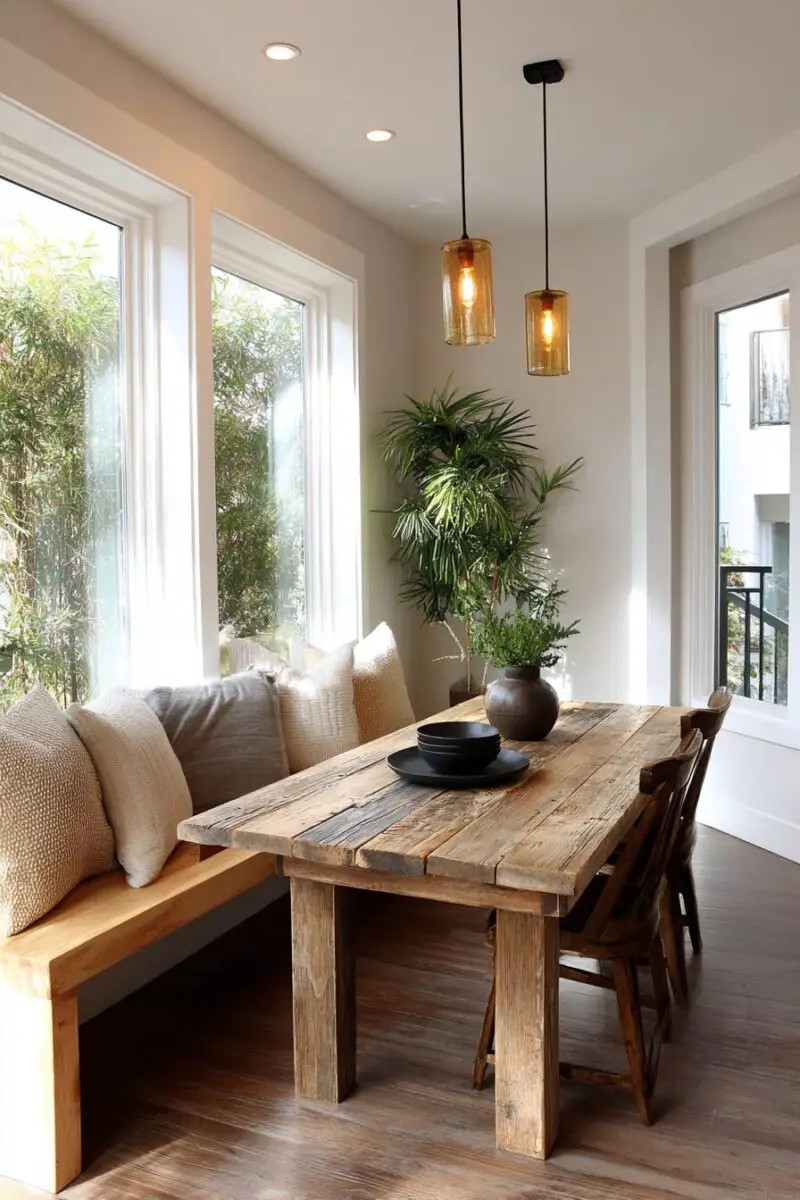
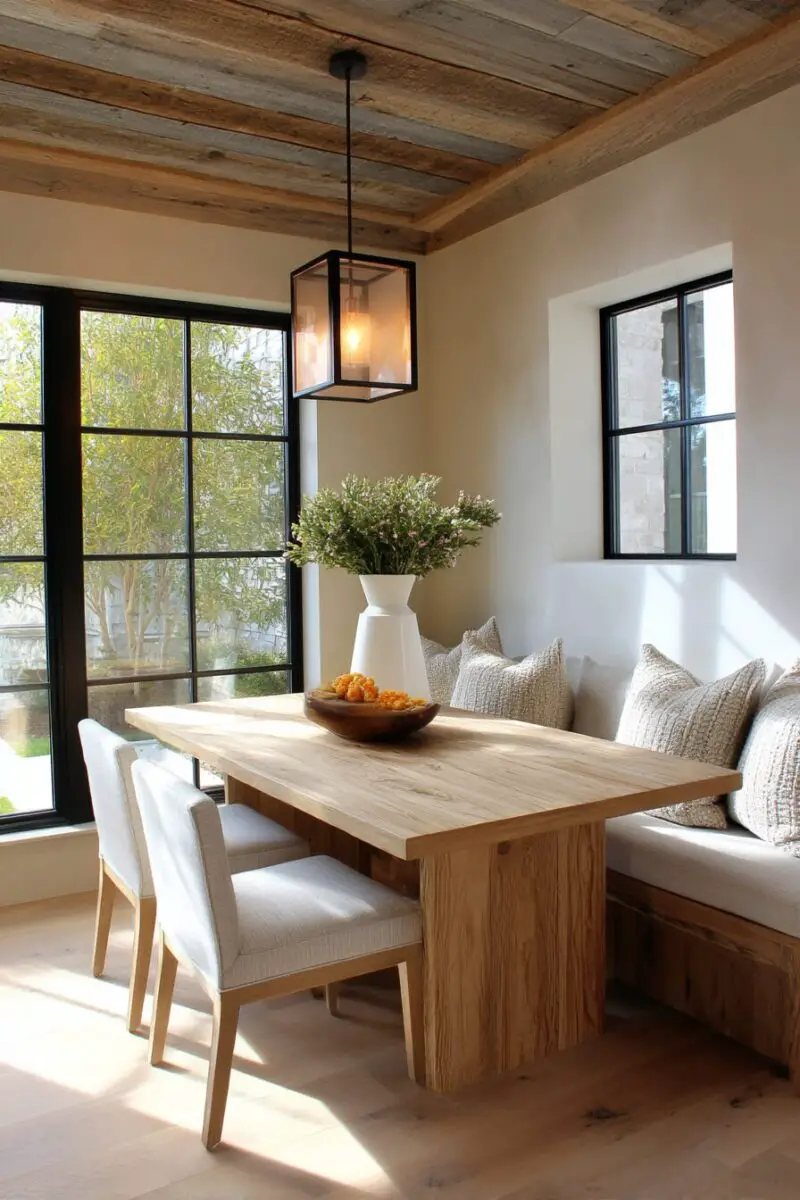
Nothing says “gather here” quite like a rustic farmhouse dining nook that balances comfort with timeless charm.
These spaces feel instantly welcoming and unpretentious, creating the perfect backdrop for everything from pancake breakfasts to holiday gatherings.
The beauty of farmhouse nooks lies in their thoughtful use of natural and reclaimed materials that tell a story and add character to your space.
Start with a reclaimed wood table – complete with knots, nail holes, and the beautiful imperfections that speak to its history.
Bench seating along one or two sides creates the casual, communal feeling that defines farmhouse style while maximizing seating for large families or frequent entertainers.
Incorporating shiplap or beadboard on the walls surrounding your nook adds textural interest and authentic farmhouse character.
Choose warm white paint for these architectural details to brighten the space while maintaining the cozy feeling that makes these nooks so appealing.
Overhead lighting becomes a focal point in farmhouse nooks – consider a wrought iron chandelier, a repurposed pulley system, or pendant lights made from mason jars.
The lighting should hang approximately 30-36 inches above the table surface, low enough to create intimacy but high enough to avoid blocking sightlines.
Window treatments in natural fabrics like linen or cotton with simple patterns (think subtle ticking stripes or small-scale checks) maintain the unfussy farmhouse vibe.
Introduce texture through woven placemats, a simple table runner, or cushions covered in grain-sack inspired fabrics.
The color palette for farmhouse nooks typically revolves around neutrals (cream, beige, gray) with judicious pops of muted color like faded blue, sage green, or brick red.
Accessories should be purposeful rather than purely decorative – think wooden cutting boards leaning against the wall, a pottery pitcher filled with wildflowers, or vintage canisters storing frequently used items.
Open shelving installed above bench seating provides display space for everyday dishes, making them both accessible and part of your decor story.
This collected-over-time approach reinforces the authentic, unfussy appeal of farmhouse style.
For comfort, add cushions to wooden benches in hardwearing fabrics like canvas or denim that improve with age and use.
Modern Minimalist Nook with Clean Lines and Smart Technology
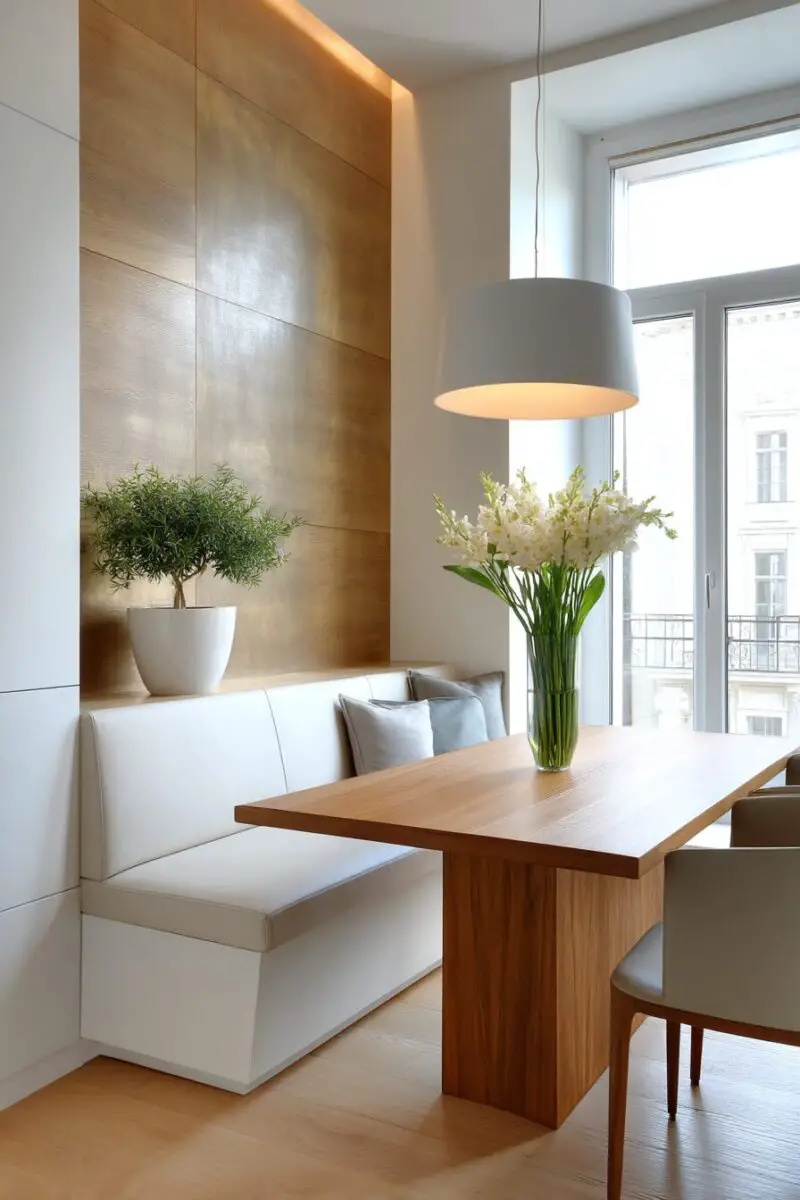
Clean lines and clutter-free surfaces create a dining nook that feels like a breath of fresh air in your busy home.
Modern minimalist nooks focus on form and function with equal intensity, eliminating the unnecessary while elevating the essential elements of dining spaces.
These sleek eating areas aren’t just visually calming – they’re designed to streamline your dining experience through thoughtful integration of technology and smart storage solutions.
Begin with a foundation of neutral colors – whites, grays, and blacks – that create a timeless backdrop for your minimalist design.
The table itself should feature clean, architectural lines – look for pedestal styles that eliminate visual clutter or slim legs that create a sense of openness and airiness.
Materials like tempered glass, polished concrete, high-gloss laminates, or engineered quartz bring durability and easy maintenance to your minimalist nook.
Incorporate smart technology that enhances your dining experience without creating visual distraction – think built-in charging stations, hidden speakers for ambient music, or smart lighting systems.
Programmable LED lighting under bench seating or along ceiling perimeters adds ambiance without cluttering the space with lamps or fixtures.
Seating should prioritize comfort through thoughtful design rather than excess padding – look for ergonomically shaped seats that support proper posture during meals.
Window treatments should be similarly streamlined – motorized blinds that retract completely or minimalist roller shades provide privacy when needed while maintaining the clean aesthetic.
Storage is concealed wherever possible – perhaps a sleek cabinet built into an adjacent wall rather than a traditional buffet or hutch that creates visual weight.
One statement piece – perhaps an architectural pendant light or a single piece of oversized artwork – provides visual interest without cluttering the space.
The table setting itself becomes part of the minimalist aesthetic, with simple white dinnerware, streamlined flatware, and crystal-clear glassware that emphasizes form over decoration.
The beauty of minimalist dining nooks lies in their ability to adapt to different functions throughout the day, from workspace to dining area to homework station, all while maintaining visual calm.
Outdoor-Inspired Botanical Dining Space That Brings Nature Inside
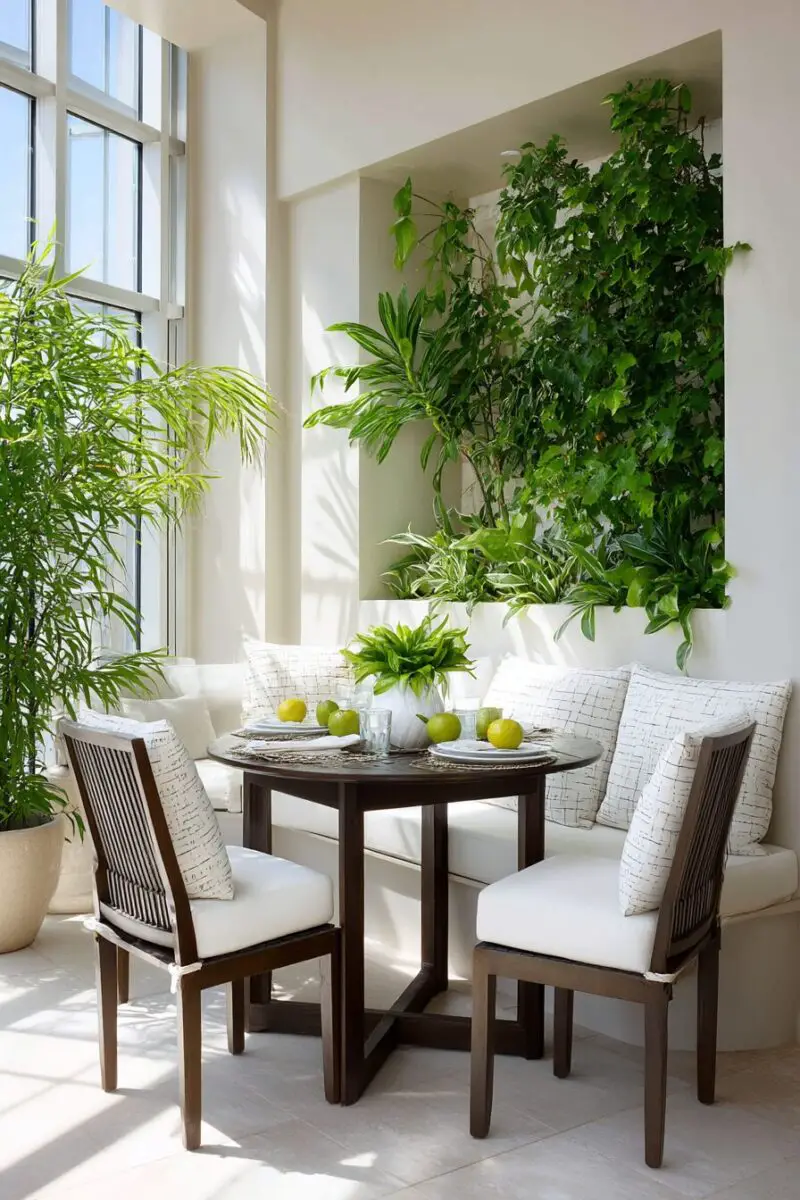
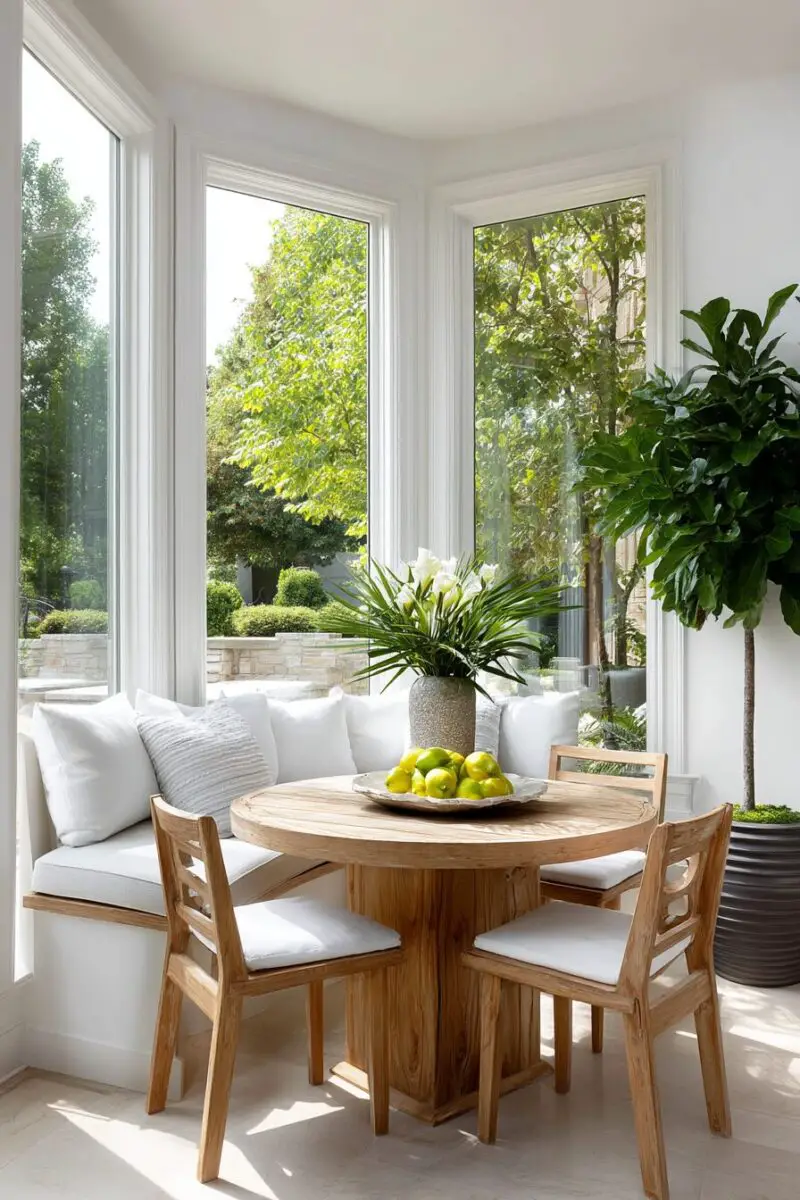
Imagine dining in a lush garden oasis regardless of the weather or season outside your windows.
Botanical dining nooks blur the boundaries between indoor and outdoor living, creating refreshing spaces that energize and calm simultaneously.
These nature-inspired corners harness the psychological benefits of biophilic design – our innate connection to natural elements that reduces stress and improves wellbeing.
Start by positioning your nook near windows whenever possible to maximize natural light, which both enhances the garden-like atmosphere and provides essential illumination for your plants.
Select a variety of houseplants in different heights, textures, and leaf shapes to create a layered, natural-looking display rather than a regimented arrangement.
Plant stands of varying heights placed strategically around your nook create natural room dividers that define the space without closing it off completely.
Choose materials that would feel at home in a garden setting – perhaps a weathered wood table, rattan or wicker seating, or stone-inspired surfaces that reference natural elements.
The color palette should draw from nature’s own playbook – botanical greens, earthy neutrals, sky blues, and the occasional pop of flower-inspired brights.
Wall treatments can reinforce the botanical theme through leafy wallpaper, a living wall installation, or simply a nature-inspired paint color like sage green or warm terracotta.
Lighting should mimic dappled sunlight filtering through leaves – consider pendant lights with perforated shades that cast interesting shadows or string lights woven through ceiling-mounted trelliswork.
Window treatments should be minimal to maximize light penetration – perhaps simple bamboo blinds or sheer curtains that filter rather than block natural illumination.
Tableware choices can extend the botanical theme through leaf-shaped serving pieces, floral-patterned dishes, or organically shaped handmade pottery in earthy glazes.
Incorporate natural textiles like linen napkins, a cotton-blend tablecloth with subtle botanical prints, or seat cushions in performance fabrics that mimic the texture of natural materials.
A small herb garden incorporated into your nook brings fragrance, visual interest, and culinary benefits – imagine snipping fresh basil directly onto your pasta at the table.
The soundtrack of your botanical nook might include a small tabletop fountain whose gentle gurgling creates a sense of being near a garden stream or pond.
TRENDING NOW
13 Chic Dining Table Decorations For Every StyleSpace-Saving Round Table Nook for Small Apartments
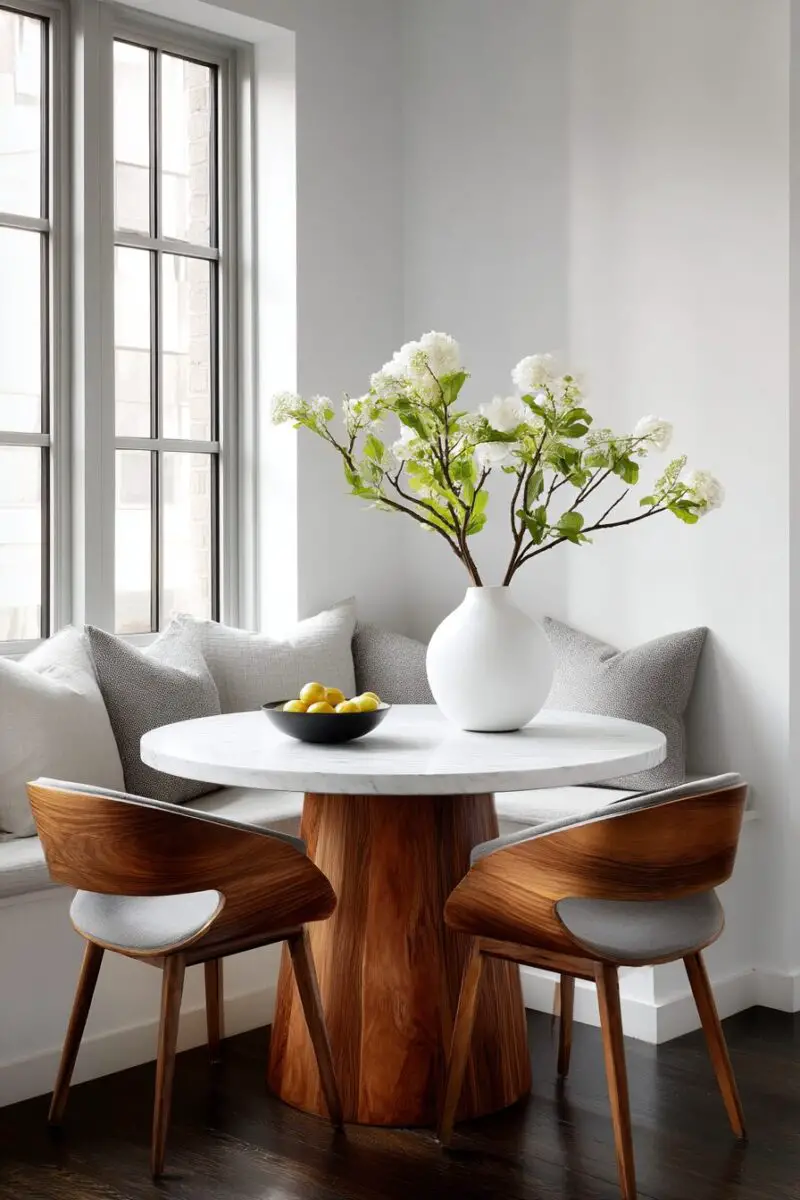
Small spaces deserve big design ideas that maximize every available inch without sacrificing style or comfort.
Round table nooks work wonders in compact apartments, eliminating sharp corners that interrupt traffic flow while facilitating conversation among everyone seated.
These circular solutions can transform even the tightest floor plans into functional dining areas that feel deliberately designed rather than compromised.
Start by selecting a round pedestal table that eliminates cumbersome legs that limit seating flexibility and create visual clutter.
The ideal diameter for small spaces is 36-42 inches, which comfortably seats four while maintaining breathing room around the perimeter.
Wall-mounted banquette seating that follows the curve of your round table maximizes seating while minimizing the floor space dedicated to your dining area.
These built-in options can incorporate storage beneath the seats, transforming what would be dead space into valuable storage for items used less frequently.
For ultimate flexibility, consider a combination of built-in seating along the wall and lightweight, stackable chairs that can be added for guests and stored when not needed.
Mirrors strategically placed opposite windows amplify natural light and create the illusion of a more expansive space around your compact dining nook.
Overhead lighting should be scaled appropriately – oversized fixtures can overwhelm small spaces, so look for compact pendants or flush mounts with big design impact.
The light fixture should hang 30-36 inches above the table surface to provide proper illumination without creating a hazard for taller individuals.
Multi-functional furniture becomes essential in small spaces – perhaps chairs that can double as occasional seating in the living area or a table with built-in leaves for workspace flexibility.
Vertical storage solutions like narrow shelving units or wall-mounted cabinetry keep serving pieces and table linens accessible without consuming valuable floor space.
Color can transform small dining nooks – consider painting the wall behind your banquette in a slightly deeper shade than surrounding walls to create depth and interest.
Window treatments should be mounted close to the ceiling and extend beyond the window frame to create the illusion of larger windows and more generous proportions.
For tiny apartments, consider a glass-topped table that visually disappears, creating the illusion of more floor space while providing a durable, easy-to-clean eating surface.
Luxurious Upholstered Booth-Style Dining Nook

Restaurant-quality comfort meets residential charm in upholstered booth-style dining nooks that invite you to linger over meals and conversations.
These luxurious seating arrangements transform ordinary dining into an experience that rivals your favorite high-end restaurant booth, where you always request “that perfect corner.”
The psychology behind booth seating explains its perennial appeal – the high backs and enclosed feeling create a sense of privacy and protection that makes diners feel special and separated from household traffic and noise.
Start with commercial-grade upholstery techniques that ensure long-term comfort and durability – specify 2-inch high-density foam for seats and slightly softer foam for backs.
Channel tufting, diamond tufting, or vertical channel details add visual interest while creating ergonomic support that encourages proper posture during longer dining sessions.
Performance fabrics have revolutionized upholstered dining areas – today’s options resist stains, clean easily, and withstand years of use while maintaining the look and feel of luxury materials.
The shape of your booth becomes an important design decision – U-shaped configurations create the most intimate dining experience, while L-shaped designs better accommodate traffic flow in busier households.
Ceiling height plays a role in determining the ideal height for your booth backs – generally, 42-48 inches creates the desired sense of enclosure without overwhelming the space.
The table paired with your upholstered booth should complement its substantial presence – look for solid wood with interesting grain patterns or stone-topped tables with substantial bases.
Lighting becomes critical in booth settings – a statement pendant or small chandelier centered over the table provides both task lighting and ambiance.
Accessorize your luxurious booth with thoughtfully chosen pillows that add color contrast and additional comfort without cluttering the seating area.
For the ultimate in luxury, incorporate climate control features like seat warming for chilly mornings or cooling systems for warmer climates.
Sound-absorbing materials built into booth backs can improve acoustics, making conversation easier while reducing noise transfer to adjacent rooms.
For families with children, specify easy-clean upholstery treatments and consider slightly lower seat heights (16-17 inches rather than the standard 18) to accommodate smaller diners.
Industrial-Chic Dining Corner with Raw Materials
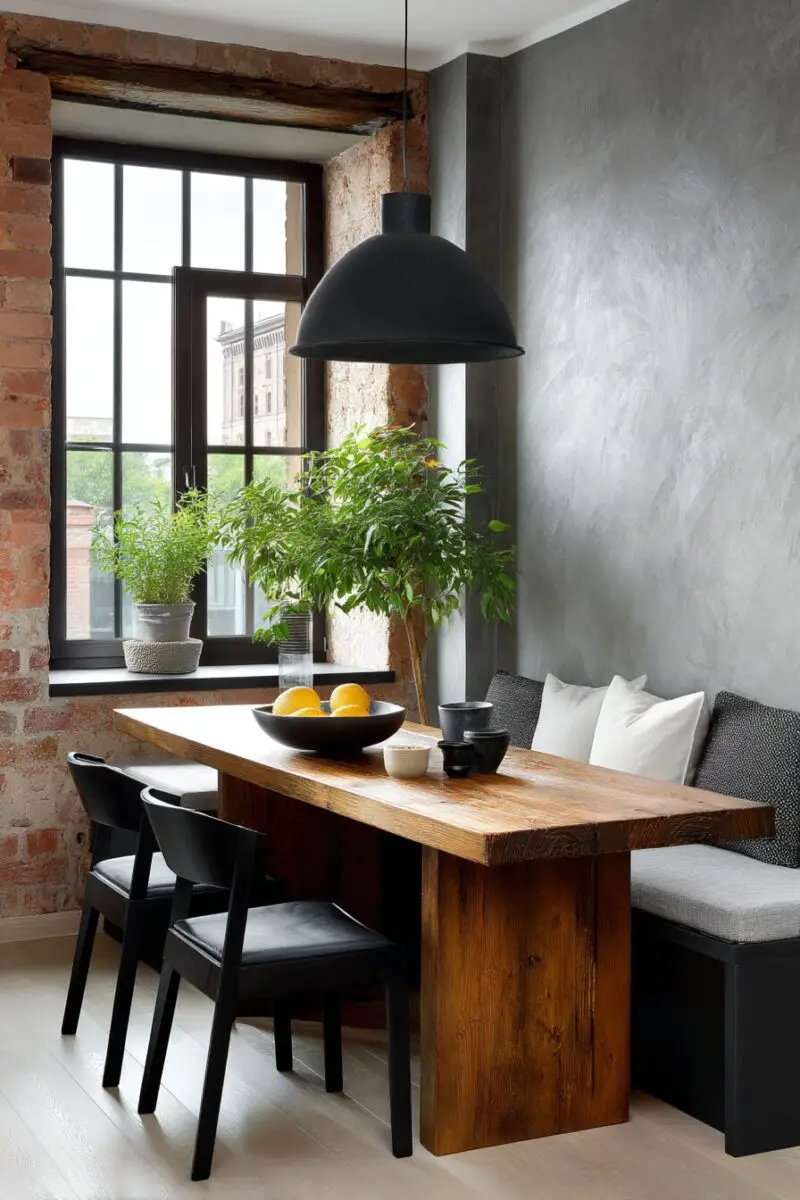
Raw materials and architectural honesty create dining spaces with undeniable character and urban sophistication.
Industrial-chic dining nooks celebrate the beauty in imperfection – the patina of aged metal, the character of reclaimed wood, and the texture of exposed brick or concrete.
These spaces tell a story through their materials, often referencing the building’s history or nodding to warehouse and factory aesthetics that feel authentic and grounded.
Start with the foundation of any industrial space – perhaps exposed brick walls, concrete floors, or steel structural elements that provide the raw canvas for your design.
If your home doesn’t naturally have these elements, consider adding them selectively – perhaps a brick veneer on one wall, polished concrete countertops, or blackened steel accents.
The dining table becomes a centerpiece in industrial designs – look for reclaimed wood tops paired with metal bases, perhaps with visible bolts or rivets that celebrate their construction.
Pipe-based furniture introduces industrial character without overwhelming your space – consider benches or chairs with black pipe frames paired with simple wood seats.
Lighting makes a dramatic statement in industrial nooks – vintage-inspired factory pendants, exposed-bulb fixtures, or repurposed industrial equipment transformed into lighting introduces authentic character.
Metal conduit used as an architectural feature to run wiring to pendant lights celebrates the industrial aesthetic rather than hiding utilitarian elements.
The color palette typically revolves around neutrals – black, white, grays, and browns – with perhaps a single pop of color through an accessory or accent piece.
Mix materials within your nook for textural interest – perhaps leather seating, metal table bases, wood tops, and glass lighting create a thoughtfully layered effect.
Scale becomes important in industrial spaces – these designs can handle larger, more substantial pieces that might overwhelm other styles, so don’t be afraid of visual weight.
Window treatments should be minimal and functional – perhaps simple roller shades in canvas or metal blinds that reference factory windows.
Introduce subtle softness through textiles to balance the harder edges of industrial design – consider wool throws, linen napkins, or canvas cushions that add comfort without undermining the aesthetic.
Vintage industrial objects repurposed as accessories – perhaps old factory molds as wall art or antique tools as sculptural objects – add authentic character to your dining nook.
The beauty of industrial-chic spaces lies in their honesty – exposing structural elements, celebrating utility, and finding beauty in objects designed for function rather than decoration.
Colorful Eclectic Nook with Mix-and-Match Seating
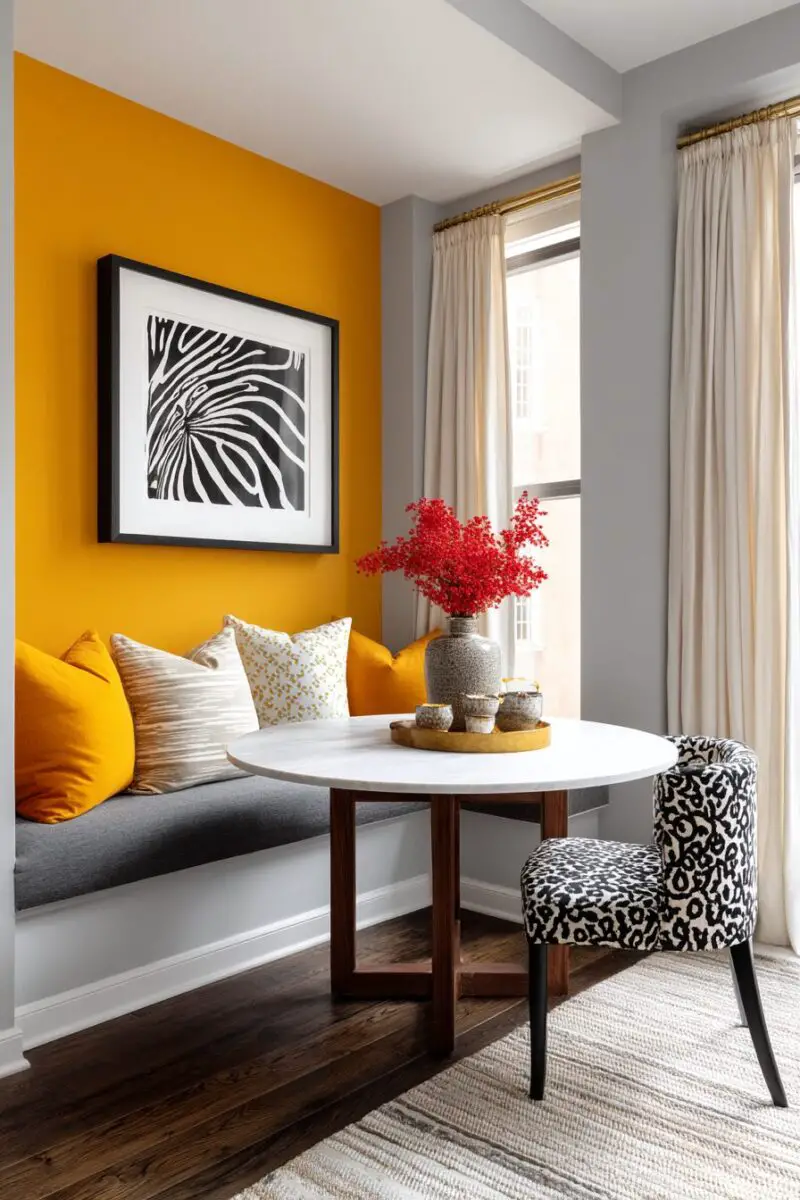
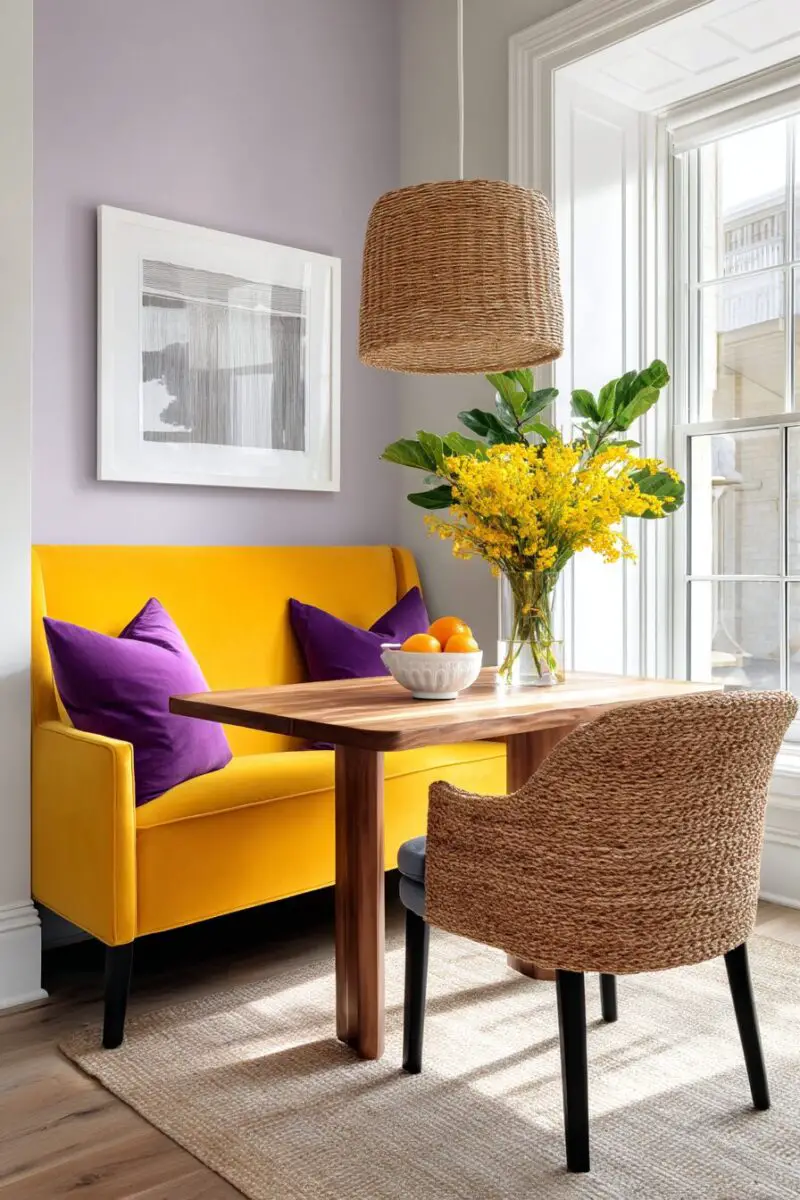
Rules were made to be broken in eclectic dining nooks where personal expression trumps design conventions.
These vibrant, personality-filled spaces celebrate color, pattern, and the beauty of curated collections that tell your unique story.
The secret to successful eclectic spaces lies not in randomness but in thoughtful curation – finding the common threads that tie diverse elements together into a cohesive whole.
Start with a color story that provides the framework for your eclectic mix – perhaps three main colors that repeat throughout the space in different proportions and applications.
Mismatched chairs unified by a similar silhouette or painted in coordinating colors create seating that feels intentionally curated rather than haphazardly assembled.
The dining table becomes a grounding element amid the eclectic mix – either a vintage find with its own character or a simple, neutral piece that allows other elements to shine.
Gallery walls featuring a mix of artwork in different styles, unified by similar framing or thematic connections, add personality and visual interest to walls surrounding your nook.
Textiles introduce pattern and texture – consider mixing florals, geometrics, and solids in complementary colors for seat cushions, tablecloths, or nearby window treatments.
Lighting choices can further the eclectic story – perhaps a vintage chandelier, colorful pendant, or even a collection of different hanging lights grouped together at varying heights.
Open shelving displays collections that spark joy – perhaps vintage glassware, international ceramics, or serving pieces collected during travels that infuse personal meaning into your dining space.
Layer different patterns by varying their scale – perhaps wide stripes paired with small florals and medium-scale geometrics that complement rather than compete with each other.
Tablescapes become an extension of your eclectic style – mix vintage and modern dishes, collected glassware, and textiles that continue your color story and personal aesthetic.
Floor coverings can anchor your eclectic mix – perhaps a vintage rug with colors that tie into your overall palette or a modern interpretation of traditional patterns.
Plants and natural elements add life to eclectic spaces – consider displaying plants in containers that continue your mix-and-match approach, from vintage pottery to modern ceramics.
The beauty of eclectic dining nooks lies in their ability to evolve over time, incorporating new finds and reflecting your changing tastes while maintaining a sense of personal history and meaning.
Multi-Functional Dining and Work Nook for Modern Living
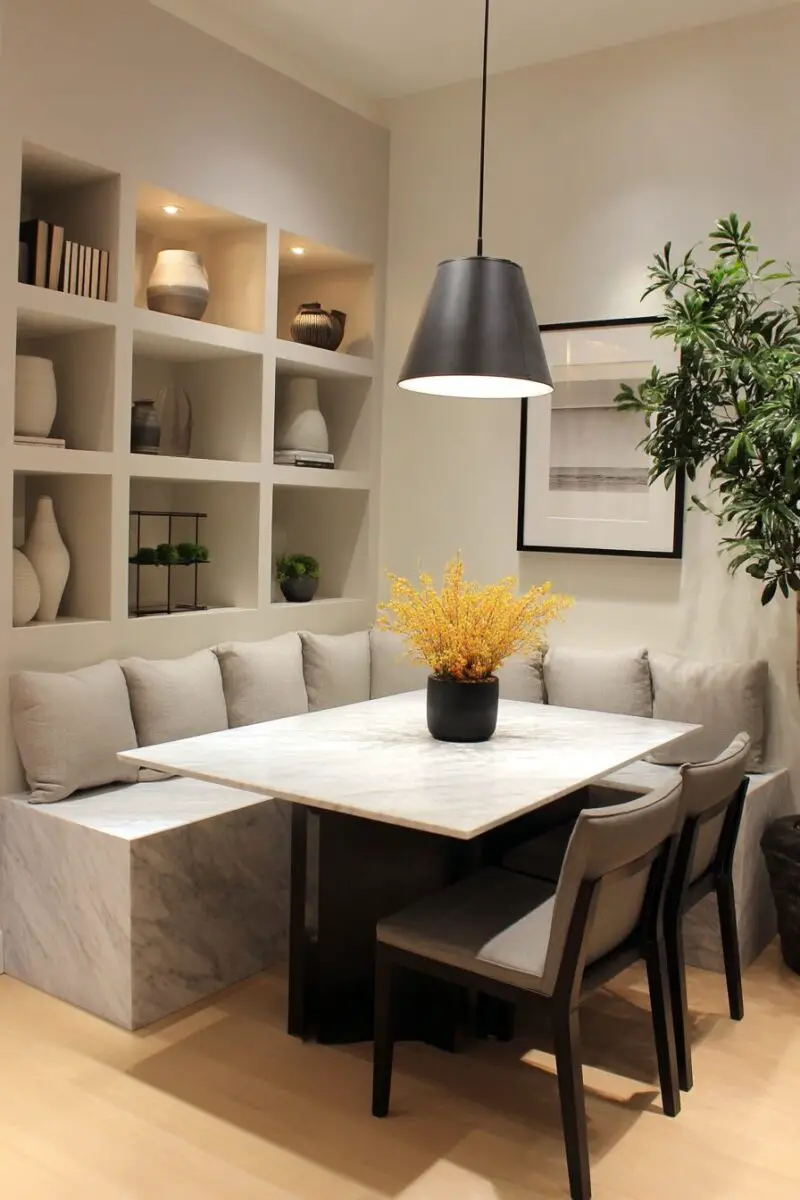
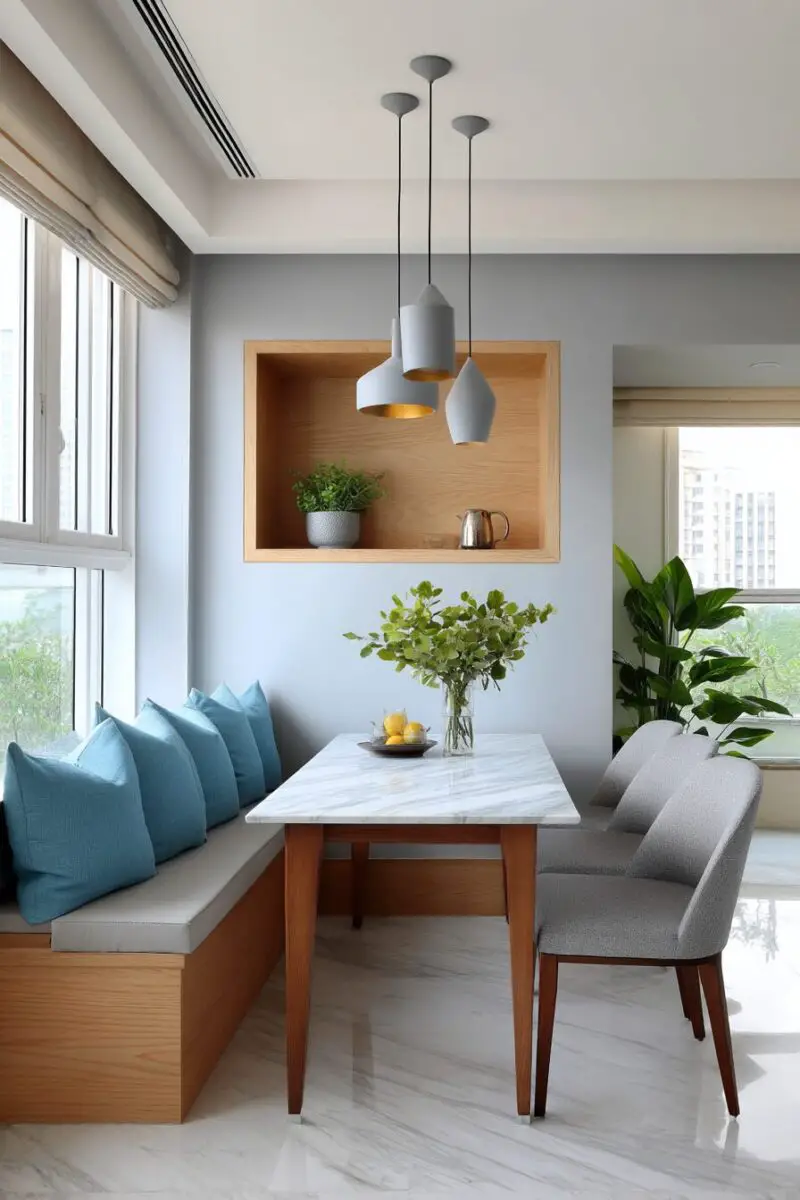
Today’s homes must work harder than ever, with spaces that transition seamlessly between different functions throughout the day.
Multi-functional dining nooks acknowledge this reality, creating brilliantly designed corners that serve as meal spaces, home offices, homework stations, craft areas, and gathering spots.
These hardworking spaces succeed through thoughtful planning that anticipates different uses and incorporates the infrastructure needed for quick transitions.
Start with a table surface that can handle the demands of both dining and work – perhaps a hardwood with a durable finish or a quartz-topped table that resists stains and damage.
Built-in power solutions become essential in multi-functional nooks – look for tables with integrated outlets and USB ports or custom solutions that bring power exactly where you need it.
Cable management systems prevent technology clutter – perhaps grommets in the table surface, cable channels along table legs, or baskets mounted underneath to corral cords.
Lighting needs to adapt to different functions – consider adjustable-arm wall sconces, pendant lights on dimmer switches, or track lighting that can be redirected for different activities.
Task lighting becomes particularly important for work functions – perhaps a sleek desk lamp that complements your dining decor while providing focused illumination for detailed work.
Storage solutions should accommodate both dining and work necessities – consider built-in benches with compartments designated for specific functions.
Vertical storage maximizes functionality without consuming floor space – wall-mounted shelves, pegboards for frequently used items, or magnetic boards for notes and reminders.
Seating should prioritize comfort for longer sitting sessions – look for ergonomically designed chairs with proper back support rather than purely decorative options.
Surface protection becomes important in multi-use spaces – perhaps beautiful placemats that also serve as desk blotters or a reversible table runner with different surfaces for dining versus work.
Technology integration should feel seamless – consider monitor arms that swing away when not needed or printer stations concealed within nearby cabinetry.
Acoustic considerations matter in spaces used for concentration and calls – incorporate sound-absorbing elements like fabric wall panels, cork board features, or upholstered seating that minimizes echo.
Color psychology can help define the space for different uses – perhaps cooler, more energizing colors for workday functions with warmer lighting and accessories introduced for evening dining.
The most successful multi-functional nooks include a quick-cleanup system – perhaps a decorative box or basket that collects work items at mealtime, allowing for 30-second transitions between functions.
Remember that the best dining spaces reflect your unique lifestyle, accommodating how you actually live rather than adhering to rigid design rules.
Start planning your dream nook today – your future self will thank you over countless meals, conversations, and moments that matter.

